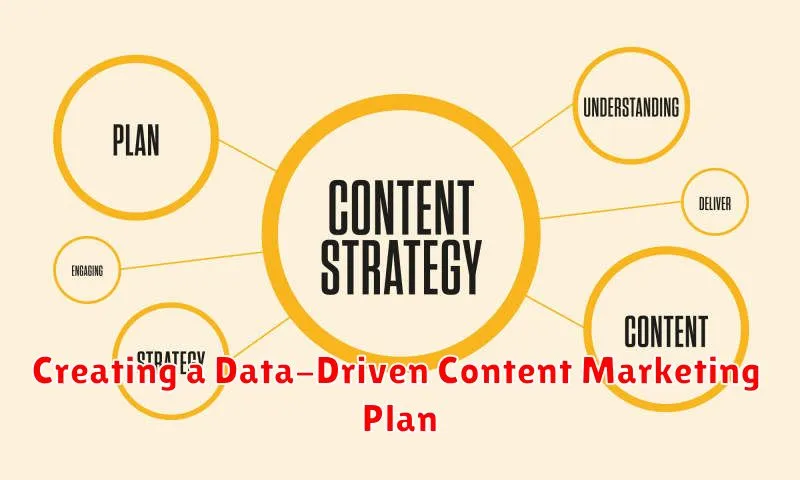In today’s digital landscape, a robust content marketing strategy is no longer a luxury, but a necessity. However, simply creating content isn’t enough. To truly resonate with your target audience and achieve measurable results, your content strategy must be data-driven. This means leveraging the power of data analytics to inform every stage of your content creation process, from topic selection and keyword research to content promotion and performance measurement. Creating a data-driven content marketing plan allows you to understand what your audience wants, optimize your content for maximum impact, and ultimately achieve your marketing goals. By focusing on data, you can move beyond guesswork and develop a content strategy that is both effective and efficient.
This article will provide a comprehensive guide to creating a data-driven content marketing plan. We will explore the key steps involved in leveraging data to inform your content strategy, including how to identify your target audience, conduct keyword research, develop engaging content formats, and track your results. We’ll discuss the importance of utilizing various data analytics tools and techniques to gain valuable insights into audience behavior, content performance, and market trends. By the end, you will be equipped with the knowledge and resources necessary to create a data-driven content marketing plan that delivers tangible results and drives business growth.
Setting Measurable Content Goals
Setting measurable content goals is crucial for demonstrating the effectiveness of your content strategy. Without quantifiable objectives, it’s impossible to track progress, identify areas for improvement, or ultimately justify the resources invested in content creation. Measurable goals should always be tied to specific key performance indicators (KPIs) that directly reflect the desired outcome. For example, instead of aiming to “increase brand awareness,” a measurable goal would be to “increase website traffic by 20% in the next quarter.” This provides a clear target and allows for accurate measurement of success.
Identifying the right KPIs is essential for effective goal setting. Consider your overall business objectives and how content can contribute to their achievement. Common content marketing KPIs include website traffic, lead generation, social media engagement, and conversion rates. The KPIs you choose will depend on the specific purpose of your content. For instance, if your goal is to drive sales, you might focus on KPIs like conversion rates and lead generation. If your goal is to build brand awareness, you might prioritize metrics like website traffic and social media engagement.
Once you have established your measurable goals and corresponding KPIs, it’s important to regularly track and analyze your progress. This allows you to identify what’s working, what’s not, and make necessary adjustments to your content strategy. Regular monitoring also enables you to demonstrate the return on investment (ROI) of your content efforts and secure ongoing support for your initiatives.
Finding the Right Audience Segments
Identifying the right audience segments is crucial for effective marketing. It involves dividing your potential customer base into smaller groups based on shared characteristics. These characteristics can include demographics (age, gender, location, income), psychographics (lifestyle, values, interests), and behavioral patterns (purchasing habits, brand loyalty, product usage). By understanding these segments, you can tailor your messaging and offers to resonate with each group’s specific needs and desires, ultimately maximizing your marketing ROI.
Effective segmentation requires thorough research and analysis. Utilize data analytics tools to gather information about your current customer base and identify potential new markets. Consider conducting surveys, focus groups, and interviews to gain deeper insights into customer motivations and preferences. Analyzing website traffic, social media engagement, and purchase history can also provide valuable data for segmentation. This data-driven approach enables you to create highly targeted campaigns that reach the right people with the right message at the right time.
After identifying potential segments, it’s essential to evaluate their viability. Consider the size of each segment, their potential profitability, and the accessibility of reaching them. A large segment might seem attractive, but if it’s difficult to reach or has limited purchasing power, it might not be worth pursuing. Focus your efforts on segments that offer a strong balance of size, profitability, and accessibility to optimize your marketing spend and achieve your business objectives.
Using SEO and Search Trends

Search Engine Optimization (SEO) is crucial for online visibility. It involves optimizing website content to rank higher in search engine results pages (SERPs). By understanding and implementing SEO best practices, businesses can attract more organic traffic, increasing brand awareness and potential customers. Key components of SEO include keyword research, on-page optimization (like title tags and meta descriptions), and off-page optimization (such as link building). Regularly monitoring website performance and adapting strategies is essential for sustained success.
Analyzing search trends provides valuable insights into user behavior and evolving interests. Tools like Google Trends offer data on popular search queries, helping businesses understand current demands and predict future ones. By aligning content with these trends, companies can create relevant and engaging material that resonates with their target audience. This data-driven approach allows for more effective content creation, targeted advertising campaigns, and overall improved marketing strategies.
Integrating SEO with search trend analysis is a powerful combination. By optimizing content for relevant keywords and incorporating trending topics, businesses can significantly enhance their online presence. This synergistic approach ensures that content is both optimized for search engines and aligned with current user interests, maximizing reach and engagement.

